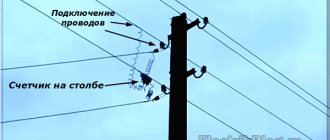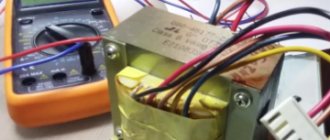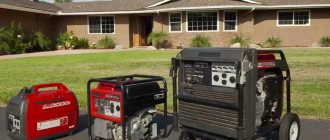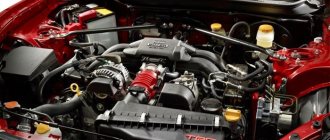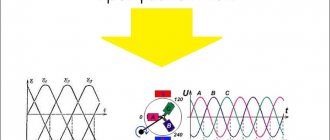Let's make a gas generator together with our own hands
Gasoline generator is a power plant with two-stroke or four-stroke gasoline engines, into which an asynchronous or synchronous alternating current generator can be installed.
When there are frequent power outages, a DIY gas generator is the ideal solution to maintain the flow of electricity. A gas generator is no less necessary for industrial purposes, for example, when working with a welding machine. The average operation of the device with a full tank of fuel can vary from 5 to 10 hours depending on the power output and fuel consumption.
- Design features of the equipment
- We do it ourselves
- Stages of assembly of the unit
- All the pros and cons
- Expert advice
How to make light without a generator
You can create light on your motorized equipment without using an electric generator - using an LED lamp and a 12-volt battery. A car battery, and not necessarily a new one, is quite suitable for this purpose. A gel battery taken from an electric scooter or electric bicycle is also suitable, or it can be found on a motor scooter.
Your main task is to choose the right place on your unit where the battery will be located. Usually the battery is small in size, so it is better to install it on the section of the frame between the engine and gearbox. So, when you have decided on the location of the battery, you can start installing it:
- Prepare a mount from a steel angle to the dimensions corresponding to the battery;
- Place the finished mount on the walk-behind tractor frame and securely attach it with bolts at four points;
- Place the battery into the mount and secure it with two bolts, nuts and a metal plate;
- Stretch the electrical wire from the battery to the switch, and from there to the electrical equipment (for us, this is the headlight). Secure all wire connection points by soldering and be sure to insulate with insulating tape.
Typically, a battery-powered headlight produces uniform and intense light. The battery capacity is enough for several hours of operation, but be prepared for the fact that you will have to periodically charge it from a source that contains electrical energy.
What kind of gasoline to pour into a gas generator
In most cases, A92 fuel is best suited for gasoline generators. In practice, gasoline with a higher octane number does not provide any great benefits, and its cost is significantly higher. When using a four-stroke gas generator, fuel must be poured into the tank in its pure form, while to refuel a station with a two-stroke engine you will need to mix gasoline and engine oil. This procedure is performed to ensure reliable and stable operation of the engine, extending the operating period and reducing fuel consumption. It should be noted that gasoline generators with two-stroke engines have much more toxic emissions than four-stroke engines. When choosing oil for a generator, it is necessary to take into account that they can be summer and winter, as well as mineral or synthetic, which affects their viscosity and fluidity under different conditions. Before purchasing and using oil, be sure to read the recommendations and advice of your power plant manufacturer.
In most cases, gasoline and oil for refueling two-stroke engines are pre-mixed, outside the equipment, but some models of gasoline generators are equipped with an automatic mixing system.
- Model:
EP 25000 TE in container with AVR - Power:
16 kW - RUB 1,079,740
- Model:
AB10-T400-VM111E in container - Power:
10 kW - RUB 291,690
- Model:
LT 3500 CL - Power:
2.5 kW - 19,600 rub.
Why do you need to turn off the generator engine by closing the fuel supply valve?
Listen to the advice of a portal user who professionally maintains power plants.
Genmos
Most often, the generator does not start due to a malfunction of the fuel system. Therefore I recommend:
- Keep the carburetor dry.
- Turn off the generator by turning off the fuel valve until all the fuel is used up.
This way, there will be no gasoline left in the carburetor, and the electrical part of the station will cool down more evenly. This is especially useful for three-phase generators. How many times has it already happened? The client bought the station about 5 years ago. I filled the tank with gasoline. Never started the generator or changed the fuel. The lights were turned off, but the generator would not start. A man calls me and asks what should he do? And every time, the reason is in the carburetor and in the fuel system. To maintain the generator’s combat condition, I advise:
- Start it once a month and run it under load for 30 minutes.
- Turn off by turning off the fuel valve.
- Change the oil according to operating hours or once a year.
- When purchasing a new generator, run it at 50% power.
An important nuance: in winter, it is not recommended to keep the generator tank half empty or leave fuel at the bottom. Fill your tank full. Why? At subzero temperatures and sudden thaws, the metal from the inside, if the tank is half empty, fogs up. Then this frost melts and water gets into the gasoline.
How to choose a gas generator
A gasoline generator (or fuel energy generator) is an autonomous portable power station that is used in construction, welding and installation work, and in everyday life as the main and additional power source. Depending on the model, the unit allows you to connect one or more electrical appliances at the same time. In this article you will learn how to choose a gas generator for welding, power supply to your home, workshop or workshop, and which brands are most popular among Russian users.
Depending on the model, from 2 to 4 sockets with a voltage of 12, 220 or 380 V can be installed on the generator body for connecting various electrical appliances. Not all generators can be connected to any device. Welding electrical equipment requires a special gas generator for welding. It differs from the usual one in higher power and low voltage, which is important for welding inverters and plasma cutting machines.
Popular generator manufacturers
Decided to buy a gasoline generator - which brand is better to choose? This is one of the first and important questions facing the buyer. Today, there are a large number of domestic and foreign brands of European and Asian origin on the special equipment market. The most popular brands:
Features of a car generator
After turning the ignition key, current flows into the field winding. Here it is controlled by a voltage stabilizer, which is powered by the rectifier section.
Today they are connected according to two main schemes. The older version is reliable, works stably, maintaining voltage at approximately a constant level. The updated scheme has many disadvantages.
The uniqueness of the automobile unit is that it generates electricity by converting the mechanical energy of the rotating engine crankshaft, which is connected to the generator pulley by a belt. At the same time, the engine speed is not a constant value.
In this case, regardless of engine speed, the voltage should always remain within approximately 14 Volts. Otherwise, it will negatively affect both the battery and the electrical circuit. Overcharging and undercharging will have a detrimental effect on the battery.
The operating principle of electronic speed stabilization is based on the dependence of the capacitor resistance on the current frequency. The diagram shows a stabilizing winding (L3) loaded onto a capacitor (C1). When operating at rated load, the output voltage is 220 V with a frequency of 50 Hz. Since the frequency of the output voltage directly depends on the number of revolutions per second, a change in the rotation speed of the generator rotor causes an unambiguous change in the voltage frequency on all windings of the generator.
The resistance of a capacitor depends on the frequency of the applied voltage. The higher the frequency, the lower the resistance. As a result, the current through the stabilizing winding varies depending on the load on the generator. As the load decreases, the number of revolutions increases, respectively, the frequency increases and the resistance of the capacitor decreases.
Electrical stabilization operates over a small range of changes, so the main adjustment function is assigned to the mechanical regulator. Here the range of adjustments is much wider, but at the expense of reaction speed. The internal combustion engine has inertia, and the change in its speed is slightly delayed when adjusting the throttle valve (this characteristic of the engine is called throttle response). Sudden load surges can cause the control system to oscillate.
Such a regulation system is difficult to make on your own, and an electronic one requires modification of the generator. The advantage of such a control circuit is the production of sinusoidal voltage with minimal distortion of the signal shape.
Inverter Gasoline Generator
The alternating voltage of the generator is supplied to the rectifier, and then to the transistor converter, the output of which is a stabilized voltage of the required value. The presence of a rectifier removes restrictions on the stability of the generator frequency, and the transistor converter generates voltages regardless of the load size. The disadvantage of inverter generators is their high cost and distortion of the output voltage waveform.
How to choose a generator for your home: power calculation, phases, engine type
Finally, you asked yourself this question - what will happen if the lights are turned off? There are a lot of unpleasant things - the house will defrost, information will disappear, production will lose power, a pump, machine will stop working, etc.
And... You decided to acquire your own independent source of electricity (generator, diesel generator, mini-electric power station, gas generator, etc.).
Do you want to fully provide yourself with electricity or only provide the most basic needs: lighting, refrigerator operation, heating and/or alarm system support, water pump, etc.?
Therefore, the first question will be the rated electrical power (PRP) of the generator (generator set) you are purchasing.
You must determine for yourself which consumers will be connected to the generator at the same time. It is best to check the power of consumers using their passport data.
To calculate the power of the selected generator, take triple the rated power of the electrical appliance with the largest electric motor, add to it the power of all other active consumers (lighting, electric stove, kettle, etc.).
The resulting power must be multiplied by the one-time use coefficient (or demand coefficient) equal to 0.6-0.8 - this is the power of the generator you need.
The second question that you need to decide: should your generator (diesel generator, gasoline generator) be 1-phase (230 V) or 3-phase (400 V)?
If you do not have 3-phase consumers at your site and a 1-phase network is connected to your house (dacha), then the choice here is clear: a 1-phase generator.
If you do not have 3-phase consumers, but a 3-phase network is connected to your house (dacha), then you still need a 1-phase power supply unit, since having purchased a 3-phase one, you will be forced to “parallelize” the output into three 1-phase ones. phase lines by analogy with the supply from the external network.
If you have a synchronous generator, then the difference in the load of each winding should not exceed 30%, if the generator is of an asynchronous type, then no more than 60%, which is better, but not entirely good, since it is a big inconvenience to constantly calculate, how many kilowatts and to which phase (generator winding) must still be connected or additionally loaded until an approximate uniformity of phase loading is observed.
And only in the case when there are 3-phase consumers, it is necessary to purchase a 3-phase PG.
The third question is, what engine should your generator be equipped with - diesel or gasoline?
They often ask: “Which is better?”, “What do you recommend?”
This question cannot be answered unequivocally. Each type of engine has its own advantages.
However, if we are talking about electrical power above 15 kVA, then it is impossible to find a generator with a gasoline engine on the power plant market, and diesel engines in this power range are mostly liquid cooled.
— The speed of rotation of the motor shaft is important. For gasoline engines, which are almost all air-cooled, it is 3000 rpm, as is the case for air-cooled diesel engines.
A diesel engine with liquid cooling (antifreeze) has an engine shaft rotation speed of 1500 rpm. Such engines are capable of operating around the clock.
And the noise from them is less than from the same, but spinning twice as fast, so-called “backup generator”, the resource of which is much shorter due to the high speed of rotation of the shaft.
By the way, all gasoline mini-power plants, as well as air-cooled diesel generators, are backup.
- Noise. There are no absolutely silent generators. The fight against noise is traditional - an enlarged muffler and a noise-proof casing. But at the same time, the price increases significantly, as well as the dimensions and weight.
But I want it to launch itself - is this possible?
Autostart. All generators with an electric starter can be equipped with an autostart system. Then human participation in the event of a power failure is reduced to monitoring the fuel.
NO momentary power loss.
Well, one more thing - if it is important that there is no loss of power supply even for seconds, then you need to additionally install a UPS (uninterruptible power supply or UPS).
Interfacing the engine and generator
Rotation from the engine to the generator is transmitted by a belt drive or gearbox. But the gearbox has a large mass and high noise, so it is better to use a belt drive.
Engines and generators have different nominal speeds, so the pulleys on the shafts of these devices must provide a certain gear ratio. It is calculated simply: how many times the generator speed should be less than the engine speed, the same number of times the diameter of the generator pulley should exceed the diameter of the engine pulley.
Note! You should not take the pulley diameter too small, since strong bending of the drive belt will shorten its service life, and the efficiency will decrease, since part of the engine power will be lost due to bending of the belt. In practice, pulleys with a minimum diameter of at least 100 mm can be used.
It is tempting to use generators with original pulleys. But, if a flat belt is used, then it is quite difficult to find one of the required length, therefore, in order to facilitate the search for the right belt, the pulleys need to be made for a V-belt. There are many such belts of all possible lengths in any auto shop or car market, and their cost is low.
Pulleys are made of duralumin or textolite. Any turner can do this for a nominal fee. The main thing is to ensure a tight fit on the generator and engine shaft.
Basic installation recommendations.
Gas generators are installed both indoors and outdoors. If the unit is installed outdoors, it is necessary to protect it from aggressive factors such as precipitation or dirt. The electric unit can be placed in a barn or other outbuilding. Such placement is also optimal due to such properties of the electric generator as fire hazard, noise and the presence of harmful exhausts.
When placing the gas generator inside a residential building, it can be installed in a ventilated basement or garage.
To eliminate vibrations, the generator must be installed on a perfectly flat surface. There are certain requirements for the premises. So, there should not be high humidity here. Otherwise, a short circuit may occur. The generator is installed in a dry place where the sun's rays do not reach. It is necessary to organize high-quality ventilation and air conditioning in the room; this is required for cooling gasoline generators with air ventilation.
It is necessary to exclude the appearance of open flame sources near gas generators. This is necessary in order to minimize the risk of fire, because the generator uses highly flammable fuel. Smoking and working with open flames should not be allowed near gasoline-powered electrical units.
On the generator
In the second picture you can see how the diode is installed, but with such a length of wiring it is not very convenient - everything is tight. It is better to make the length of the wire about 2 cm from the diode - this way, in my opinion, it will be easier to insert into the RN connector of the generator. As far as I remember, I have a K223 diode, i.e. it's silicon. Raises the voltage by about 1.3 V.
I’ll correct myself - I checked using reference data on the Internet what the K223 diode is - I must say that I was very mistaken in indicating exactly that name. In fact, there are diodes KD223 and D223, but their housings are completely different.
However, in the photos I provided, most likely diodes D214 or D242 are wrapped in electrical tape (there may be different letters after the numbers), here is the case (M6 thread):
Recommendations for use
If you follow simple rules for operating the equipment, it will function stably and for a long time:
- Before turning on, you should make sure that the equipment is in good working order and tight;
- all components must be securely fastened, otherwise the installation will quickly fail due to vibration;
- it is necessary to monitor the oil level and the quality of gasoline;
- Regular cleaning of the air filter is necessary;
- Correct load adjustment is required.
Active conductor length
Active conductor length, calculation of generator coils
Now let's try to calculate the generator voltage, but first we'll deal with the generator coils
Generators come in both single-phase and three-phase. As a rule, beginners make single-phase generators considering them simpler, but single-phase ones hum during operation, since the number of magnets and coils in such generators is the same. And it turns out that when the magnets run into the coils, the coils resist this and repel the magnets. As a result, there seems to be a peak in resistance and a decline, which causes buzzing and vibration. Three-phase ones are designed differently, there is a 2/3 displacement of the coils relative to the magnets, and due to this the load is evenly distributed, which makes the vibration much lower. Also, the power characteristics are somewhat better, and the circuit is not much complicated.
Below is a connection diagram for a single-phase generator
Calculator for calculating the required power of a gasoline generator
There are many cases in life in which the presence of an autonomous power source turns into an urgent necessity. This becomes relevant for residents of populated areas, where the state of the electrical networks is such that drops in the network or even a loss of voltage are by no means uncommon. Sometimes you need a gasoline generator in holiday villages - not all of them have reliable power lines yet. It is of great importance for people who have received plots for development: there is no time to wait for landline lines to be installed - the work must be organized immediately!
Calculator for calculating the required power of a gasoline generator
But how to choose an autonomous power plant so that it can fully cope with all the planned loads, so that the purchase does not bring quick disappointment? A calculator for calculating the required power of a gasoline generator will help the reader with this.
How to increase on-board voltage
Where and how is a diode placed in the LV circuit on the generator in order to increase the voltage in the car network and better charge the battery? Here I propose a simple solution, raising the on-board voltage, without going anywhere in the car and its circuits.
I searched in my archives and did not find the material from which I read this decision. “Structurally, voltage regulators have an upper limit of 13.6V. This is due to the “old” connection diagram, from which the new one was copied and “successfully improved”. In it, the necessary voltage from the on-board network, supplied to the regulator for comparison, passed through a chain of wires. On them it dropped to normal. According to the new scheme, we have a chronic undercharge of the battery. Which, with the arrival of winter, makes starting the engine in the cold quite problematic. But if you install a pre-heater, starting the engine will be much easier.
It should also be noted that the battery begins to absorb energy (charge) only when its temperature is above zero. Therefore, in winter, if you make short runs and the battery does not have time to warm up under the hood to at least zero (plus charging time), it will be constantly discharged. And soon it will die... It is believed that after starting the engine, in order for the battery to recover, you need to drive for at least 20 minutes. Just go, and not stand in traffic jams! How to increase the voltage in the network?
Very simple! It is necessary to make the regulator “think” that we have low voltage in the network. Thus, the generator will give us the missing volts. A diode will help us do this. In a generator with a built-in voltage regulator, you need to place a diode in the circuit, as shown in the figure.
How to reduce noise without tuning
If you'd rather avoid making any changes to the generator itself, there are still ways to muffle the sound.
- Installation as far as possible
It is so simple. The further you go, the less likely you are to hear it, so use longer extension cords if possible.
- Create a Soundproof Box
Assembling a generator box not only prevents sound from spreading, but can also serve as a space to store the generator outdoors.
Remember that fuel-burning generators require adequate ventilation to prevent dangerous levels of carbon monoxide from building up. Fire retardant insulation material is a good material for this.
- Install sound deflectors
Sound deflectors are solid materials that reflect sound waves in a different direction. In some cases they are used to create a more direct line towards you, but in this case you obviously want to adjust the deflectors so that they move away from you and your home.
- Install the generator on rubber
Some noise simply comes from vibrations, so if the alternator shakes less, that can also reduce noise. A simple rubber mat under the generator is enough to reduce vibration or purchase a special anti-vibration mat.
Alternatively, buy rubber feet
The best option is to use several noise reduction methods at the same time. The generator will never be completely silent, but these tricks can reduce the uncomfortable noise level.
Restrictions
The question of how to increase the power of a gas generator arises when the equipment simply does not start, although the generator is working at full capacity. Of course, you will find a lot of advice about how to rewind the rotor winding with a larger diameter wire with fewer turns, or even some innovative developments for which they offer to pay a certain amount. But let's be honest - in nature there is a law of conservation of energy. If the engine of your generator is not capable of producing more power, then all rewinding efforts will turn out to be a failure. Moreover, they will affect the change in the parameters of the output current and voltage curve, which may adversely affect the operation of the connected equipment.

